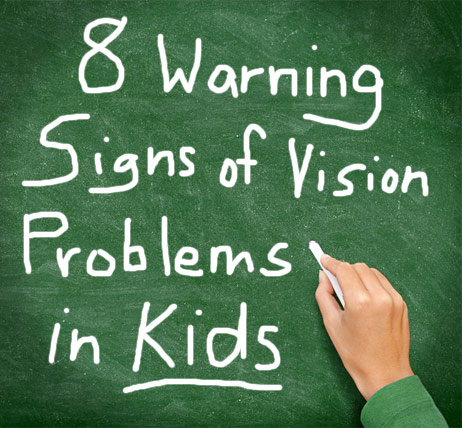Kids Vision

Kids Vision
8 signs of Vision problems in kids
Did you know that about 80 percent of what children learn in school is taught visually? That means if your child has an uncorrected vision problem, it could severely affect his or her development.
- Consistently sitting close to the TV or holding a book too close. While it is a myth that sitting too close to the TV will ruin your eyes, this habit could be a sign of a vision problem. If your child cannot see televised images clearly or read from books without leaning in close, it could mean he or she is shortsighted.
- Frequent eye rubbing. Yes, children do often rub their eyes when they’re tired or upset. But if your child rubs his eyes while he’s trying to concentrate on something, or while he is being active, it could mean that he has a vision problem.
- Losing place while reading or using a finger to guide eyes when reading. When kids learn to read and are sounding out words, they’ll often use their finger to track which word they’re on. But eventually they should be able to focus and not lose their place. If after a while your child still uses her finger, ask her to try reading aloud without pointing. If she has trouble, she may have a vision problem.
- Sensitivity to light and/or excessive tearing. Are your child’s eyes particularly sensitive to indoor lighting, sunshine or camera flashes? Children with photophobia, or extreme sensitivity to light, can develop headaches and nausea. And light sensitivity can be a symptom of several eye conditions.
- Closing one eye to read or watch TV. Frequently closing one eye could indicate a refractive or binocular vision problem that interferes with the ability of the two eyes to work together comfortably as a team. Closing one eye to read or concentrate on other desk or computer work could be a sign of a specific eye teaming problem called convergence insufficiency.
- Receiving lower grades than usual. If your child is having a hard time seeing what his teacher writes on the board because of poor vision, he may not tell you about it. As a result, his grades can suffer. If your child seems to be struggling in school, take him for a complete eye exam — glasses or contacts could be the answer!
- Avoiding using a computer, because it “hurts her eyes.” Digital eye strain is common among children who are frequent users of computers or other digital devices. Have your child take a break every 20 minutes to look at something that is at least 20 feet away for 20 seconds while she is using a digital device. If the eye discomfort persists, take her to see an eye doctor.
- Squinting or tilting the head to see the class board better. Teachers should be on the lookout for students who have to squint or tilt their heads to see the board. Until an eye exam can be performed, consider moving the child closer to the board for easier viewing.
Remember that children should have an eye exam at 6 months, again at age 3 and then regular exams after they start school.






